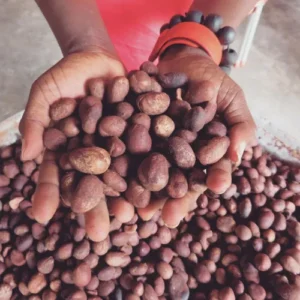The rising cost of shea butter is reshaping conversations across the natural cosmetics, wellness, and export industries. Once prized for its affordability and rich, nourishing properties, shea butter is now seeing a noticeable price surge—affecting both international buyers and producers in West Africa.
In this article, we’ll explore what’s driving the price increase, how it affects supply chains, and what both buyers and producers can expect in the months ahead.
What’s Driving the Rising Cost of Shea Butter?
Lower Nut Yields from Climate Change
The shea tree, native to the dry savannah belt of West Africa, is highly sensitive to environmental shifts. Increasingly erratic rainfall and prolonged dry seasons are leading to reduced shea nut yields. This climate pressure is a significant contributor to the rising cost of shea butter, as less raw material enters the market.
According to the International Trade Centre (ITC), climate-related factors are now one of the top risks to sustainable nut supply in Ghana and Burkina Faso.
Export Costs and Global Logistics
The global freight crisis and increased fuel costs have raised the price of exporting raw and processed shea. From port fees in West Africa to container shortages, logistics are now a major cost factor embedded into each kilo of shea butter shipped overseas.
This not only affects wholesalers but trickles down to smaller skincare brands and retailers who rely on affordable, high-quality African shea butter.
Rising Shea Nut Exports Are Creating a Local Shortage
While the global appetite for shea-based products continues to grow, there’s been a significant increase in the direct export of raw shea nuts from West Africa. International buyers, particularly from Asia and Europe, are sourcing large volumes of unprocessed nuts to refine and process in their own facilities abroad.
To counter this, several governments in the region have implemented restrictions or outright bans on raw shea nut exports, aiming to protect local processing industries and promote domestic value addition. However, enforcement remains a major challenge. Traders often bypass these restrictions through informal markets or cross-border smuggling into neighboring countries where oversight is limited and price incentives are more attractive.
This surge in raw nut exports—whether formal or informal—has resulted in a critical shortage for local shea butter producers. Artisanal processors and women-led cooperatives are often unable to compete with large-scale exporters who pay cash upfront and purchase in bulk.
As a result:
-
Local manufacturers face inconsistent access to raw materials.
-
Procurement costs continue to rise.
-
The region misses out on value-added income, job creation, and long-term industrial growth.
A recent report by the Ghana Export Promotion Authority (GEPA) shows that shea nut exports have increased by more than 60% in recent years, despite domestic demand from processors.
Economic Implications for Local Producers
Women’s Cooperatives Under Pressure
Thousands of women across Ghana and the Sahel rely on shea processing as a primary income source. Yet the rising costs and declining nut availability have made it difficult for cooperatives to meet orders, invest in equipment, or scale operations.
In many cases, price hikes do not translate into better earnings for smallholder producers. Intermediaries and export agents often absorb the margin, leaving the core workforce under-compensated and financially insecure.
Impact on Buyers and Brands
For beauty, wellness, and food industries that rely on shea butter as a core ingredient, price increases can affect everything from retail margins to product development timelines.
What Brands Should Do Now:
-
Plan ahead to manage pricing volatility in sourcing.
-
Build long-term relationships with ethical suppliers.
-
Communicate transparently with customers about sourcing and pricing.
Brands that prioritize sustainability and traceability will be better equipped to maintain quality and consumer trust—even as costs fluctuate.
Navigating the Cost Surge with Sustainable Sourcing
The rising cost of shea butter presents not just a challenge, but an opportunity: to rethink how we source, price, and value this essential African commodity. At South West Six, we work directly with rural producers to ensure our shea butter is ethically sourced, traceable, and high in quality—even as the global market shifts.
If you’re a buyer seeking consistent supply and sustainable value, contact us to learn more.


